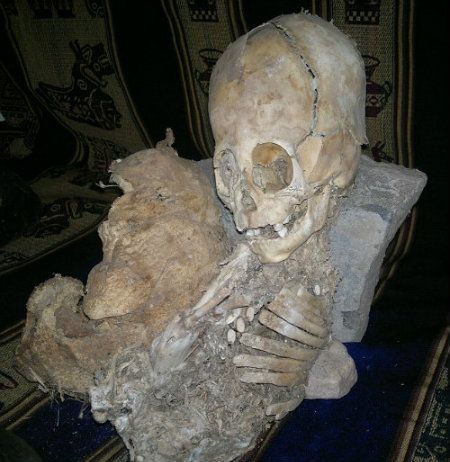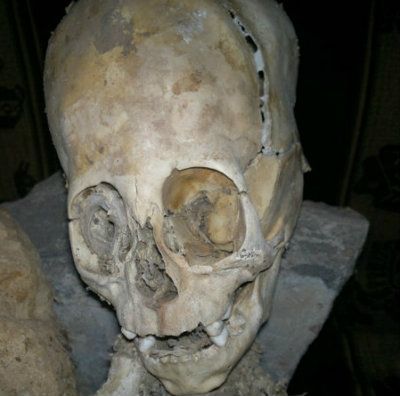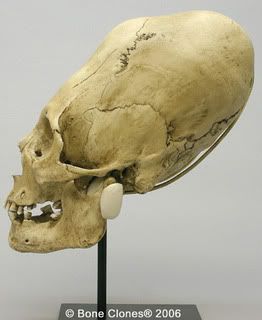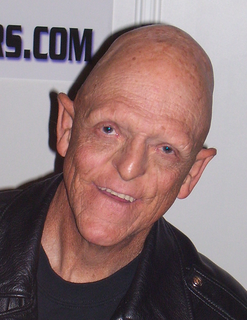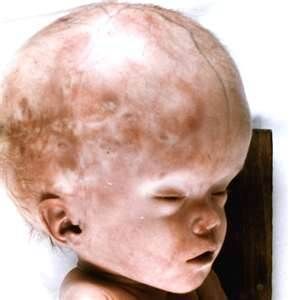"Alien Mummy" Found in Peru
A strange mummy with a huge round skull was discovered near the city of Andahuaylillas in southern Peru. The mummy was originally discovered in 2009 by Renato Davila Riquelme, who works for the Privado Ritos Andinos museum in Cuzco. While not certain of what the creature is early investigations have suggested that it may not human.
A group of un-named anthropologists from Spain and Russia also came to the same conclusion. "Although the assessment was superficial, it is obvious that its features do not correspond to any ethnic group in the world," said Riquelme. Some suggested that the creature may have been extraterrestrial due to the round shape of the head and large round eye sockets, but Requelme is not convinced, suspecting instead that it may be a genetically deformed child. Whatever it is, it definitely is mysterious.
The skull has some unusual features which differentiate it from other human skulls. There is a "soft spot" at the top of the head where the cranial bones join together which is common in human infants less than one year old. While this might suggest that the skull belonged to a child there are other features, such as a fully formed set of teeth with adult molars that suggest otherwise.
The size of the head is also unusual. The skull measures a whopping 20 inches which is almost equal to the skeleton's torso. The eye sockets are very large--much more so than any known species of hominid--and of a shape not generally found in ordinary skulls. The remains of an eyeball in one of the sockets may provide material for genetic testing.
Skeptics naturally dismiss the whole thing as a hoax, claiming that the skull is nothing more than a genetic deformity or disease, or a case of ritual skull binding. While these explanations may be possibilities there are problems with each of them.
Ritual skull binding, or artificial cranial deformation as it is scientifically known is a common occurrence among many different cultures throughout history. The procedure dates back to at least 45,000 years ago and seems to have evolved independently on several different continents.
An example of a skull that was ritually deformed
In ritual skull deformation the shape of the skull is modified or altered through the use of binding rope or cloth in order to flatten out or elongate the skull. This is usually done to newborn infants while the skull is very pliable. It is a very widespread practice throughout South America including the area where the skull was found.
The problem with claiming that ritual skull deformation is responsible for the Peruvian skull is that while the process of deformation may change the shape of the skull it does not change the size of the head or the shape or placement of the eyes. The skull found by Requelme is huge in comparison to a normal skull. The eyes are extraordinarily large also. This pretty much rules out intentional deformation as an explanation.
Strike one for the skeptics.
A second possible explanation is a genetic mutation or condition such as Hypohidrotic ectodermal dysplasia which can cause unusual characteristics to appear in an otherwise healthy human.
Actor Michael Berrymore who displays symptoms of the condition
People who have this condition may have an altered or elongated skull as well as differences in skin, hair, teeth and sweat glands. The mutations are generally nowhere near as severe as those that appear in the Peruvian skull though. The heads of people with dysplasia are not much larger than a normal person's, and while the teeth may be different they are usually smaller and pointed which is the opposite of the large rounded molars found in the huge mystery skull. The dysplasia condition also does not normally effect the eyes.
Strike two...
Another possibility is a medical condition known as Hydrocephalus, or "water in the brain." This is an abnormal condition caused by an accumulation of cerebrospinal fluid in the ventricles, or cavities, of the brain. The increase in internal pressure can cause massive swelling of the brain and can lead to an enlarged skull, possibly even as large as the one in Peru.
Infant with hydrocephalus
Side effects of Hydrocephalus are numerous and include, among other things, severe mental retardation, convulsions and in some cases, death. In order for the skull to become enlarged the condition would have to be present at a very early age, usually less than three years old, and most severe cases end up being fatal. While this condition could potentially explain the abnormally enlarged skull it would not explain the enlarged eyes since victims of Hydrocephalus retain normal sized facial features. The eyes in the Peruvian skull are much too large to be a result of increased pressure in the brain. The fully grown molars present in the skull also seem to point away from this condition since it is doubtful that anybody suffering from such a pronounced case of hydrocephalus would have survived to adulthood. Nor would it explain the rather stunted growth of the rest of the body.
Strike three for the skeptics.
There is another possibility--that the skull actually does belong to an extraterrestrial being. It does seem to closely resemble the general description given of some ETs like the typical greys which have both an enlarged head and oversized eyes. Those descriptions do not normally include huge human-like teeth though.
Just what exactly this mysterious creature is remains to be seen. It could be some very strange and unknown genetic aberration or maybe a separate species or sub-species of humans. Perhaps it is an "alien" hybrid or a humanoid with some extraterrestrial or non-human connection. That would have to be proven through scientific testing however and so far no definitive results have been produced. At this point in time DNA testing still has not been completed.
Until the tests are completed it seems that people on both sides--both the UFO believers and the skeptics--will just have to wait for an answer to the mystery.

